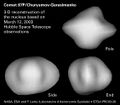Astronomy:(529366) 2009 WM1
| Discovery[1][2] | |
|---|---|
| Discovered by | CSS |
| Discovery site | Catalina Stn. |
| Discovery date | 17 November 2009 |
| Designations | |
| (529366) 2009 WM1 | |
| 2009 WM1 | |
| Minor planet category | |
| Orbital characteristics[3] | |
| Epoch 27 April 2019 (JD 2458600.5) | |
| Uncertainty parameter 0 | |
| Observation arc | 8.99 yr (3,283 d) |
| |{{{apsis}}}|helion}} | 1.3798 AU |
| |{{{apsis}}}|helion}} | 0.9810 AU |
| 1.1804 AU | |
| Eccentricity | 0.1689 |
| Orbital period | 1.28 yr (468 d) |
| Mean anomaly | 144.70° |
| Mean motion | 0° 46m 6.6s / day |
| Inclination | 25.768° |
| Longitude of ascending node | 240.27° |
| 162.62° | |
| Earth MOID | 0.0001 AU (0.039 LD) |
| Physical characteristics | |
| Mean diameter | 280 m (est.)[4] |
| Mass | 2.9×1010 kg[4] |
| Absolute magnitude (H) | 20.4[1][3] |
(529366) 2009 WM1, provisional designation 2009 WM1, is a sub-kilometer asteroid and near-Earth object of the Apollo group, approximately 280 meters (920 feet) in diameter.[4] After its discovery by the Catalina Sky Survey at the Catalina Station in Arizona, United States, this potentially hazardous asteroid was briefly listed at a Torino Scale of 1 and a cumulative Palermo Scale of −0.87.[4] It was removed from the Sentry Risk Table on 26 June 2013.[5]
Numbering and naming
This minor planet was numbered by the Minor Planet Center on 18 May 2019 (M.P.C. 114667).[6] As of 2019, it has not been named.[1]
Orbit and classification
2009 WM1 orbits the Sun at a distance of 0.98–1.38 AU once every 15 months (468 days; semi-major axis of 1.18 AU). Its orbit has an eccentricity of 0.17 and an inclination of 26° with respect to the ecliptic.[3]
Even though 2009 WM1 has an Earth MOID of 0.00009 AU (13,000 km; 8,400 mi), the orbit and future close approaches are well determined with an orbital uncertainty of 1.[3]
On 23 November 2059, 2009 WM1 will pass 0.0046 astronomical unit|AU (690,000 km; 430,000 mi) from Earth.[7] On 23 November 2199, it will make another close approach at a distance of 0.0005 astronomical unit|AU (75,000 km; 46,000 mi) to 0.069 AU, but since it is a close approach and the exact distance in uncertain, future close approaches after 2199 are uncertain.[7]
2014 passage
The 21 May 2014 Earth close approach of 0.3622 AU (54,180,000 km; 33,670,000 mi) should allow a refinement to the orbit.[7] From 7 May 2014 until 2 June 2014 the asteroid will be brighter than apparent magnitude 20.[8] The asteroid will come to opposition on 18 May 2014 when it will be up all night.[8]
References
- ↑ 1.0 1.1 1.2 1.3 "529366 (2009 WM1)". Minor Planet Center. https://www.minorplanetcenter.net/db_search/show_object?object_id=529366. Retrieved 29 May 2019.
- ↑ "MPEC 2009-W30 : 2009 WM1". IAU Minor Planet Center. 2009-11-18. https://www.minorplanetcenter.net/mpec/K09/K09W30.html. Retrieved 2012-06-26. (K09W01M)
- ↑ 3.0 3.1 3.2 3.3 3.4 "JPL Small-Body Database Browser: 529366 (2009 WM1)". Jet Propulsion Laboratory. https://ssd.jpl.nasa.gov/sbdb.cgi?sstr=2529366;cad=1. Retrieved 29 May 2019.
- ↑ 4.0 4.1 4.2 4.3 "Earth Impact Risk Summary: 2009 WM1". Wayback Machine: NASA/JPL Near-Earth Object Program Office. Archived from the original on November 27, 2009. https://web.archive.org/web/20091127152621/http://neo.jpl.nasa.gov/risk/2009wm1.html. Retrieved 2013-07-27.
- ↑ "Date/Time Removed". NASA/JPL Near-Earth Object Program Office. http://neo.jpl.nasa.gov/risk/removed.html. Retrieved 2013-09-02.
- ↑ "MPC/MPO/MPS Archive". Minor Planet Center. https://www.minorplanetcenter.net/iau/ECS/MPCArchive/MPCArchive_TBL.html. Retrieved 29 May 2019.
- ↑ 7.0 7.1 7.2 "JPL Close-Approach Data: (2009 WM1)". https://ssd.jpl.nasa.gov/sbdb.cgi?sstr=2009WM1;cad=1#cad. Retrieved 2013-01-31.
- ↑ 8.0 8.1 "2009WM1 Ephemerides for 1 May 2014 through 15 June 2014". NEODyS (Near Earth Objects – Dynamic Site). https://newton.spacedys.com/neodys/index.php?pc=1.1.3.1&n=2009WM1&oc=500&y0=2014&m0=5&d0=1&h0=0&mi0=0&y1=2014&m1=6&d1=15&h1=0&mi1=0&ti=1.0&tiu=days. Retrieved 2014-02-01.
External links
- List of the Potentially Hazardous Asteroids (PHAs), Minor Planet Center
- List Of Apollo Minor Planets (by designation), Minor Planet Center
- (529366) 2009 WM1 at NeoDyS-2, Near Earth Objects—Dynamic Site
- Ephemeris · Obs prediction · Orbital info · MOID · Proper elements · Obs info · Close · Physical info · NEOCC
- (529366) 2009 WM1 at ESA–space situational awareness
- (529366) 2009 WM1 at the JPL Small-Body Database
 |




